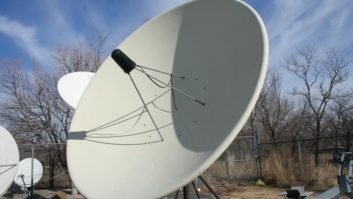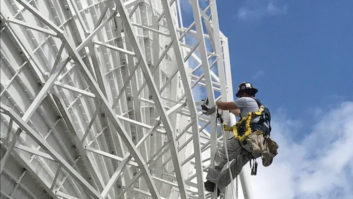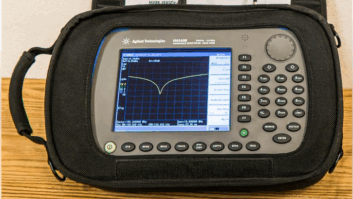In January, we delved into a caboodle of topics related to FM translators. This month, we look at their sister facilities on the senior band: synchronous AM boosters.
This concept has been around for almost a century now (yeah, you read that right), but now may finally take its place in Part 73 as a licensed service. This would be a welcome change to the unfortunate experimental science fair status under which they have languished since before Marconi passed.
These were the original towers from WBZ�s first day on the air in September 1921. They supported a flat-top antenna that was strung between the towers. When WBZ moved to Boston, this became the antenna for WBZA, and remained in use till 1962. WBZ and WBZA were synchronized in this fashion: the carrier was generated at WBZ, divided downward to an audio frequency, fed over a phone line, then remultiplied at WBZA to create a precisely-locked carrier.
Photo Credit: Scott Fybush

Synchronous AM boosters are one or more transmitting facilities added within a given region that operate(s) on the same frequency as a primary station. In order to mitigate the interference that would be expected to occur between such signals in close proximity, the frequency of their respective carriers is tightly controlled. The differential between multiple carriers gives rise to an audible signal at the frequency of the resulting product. Assuming that program material is identical at identical timing, the remaining goal is to eliminate the whistle or swoosh.
One example of this scheme being used successfully since 1998 is in Puerto Rico, but other such systems go back many more years. The concept of synchronous operation was initially suggested in 1924 by Frank Conrad of Westinghouse. The problem was that the equipment necessary to perform synchronization had to be developed. In early 1926, WBZ and WBZA, synchronization between was started using landlines and a collection of oscillators and multipliers, and ran that way until about 1928.
Around that same time, experimental synchronization took place between KDKA and KYW; however, the KYW of that time was not in Philly as it is today, but rather in Chicago. This scheme used tuning forks and a 62-meter radio circuit between Pittsburgh and Chicago in order to create the frequency reference. Further enhancements were made throughout the Depression years into the �40s. At that time, there were many systems in use. Ron Rackley notes in his comments in support of the recently filed rulemaking that synchronous facilities probably would have become even more widespread, had the commission not considered them in the limited quantity of stations a licensee could possess.
BY POPULAR DEMAND
Some four decades later, the old concept of synchronizing AM transmissions became popular again.
The commission granted several experimental licenses, and it was soon evident that synchronous AM systems could be somewhat reliable and practical. The crude crystal and tuning fork generated signals transmitted over wire lines of yesteryear gave way to digital delay devices and later, frequency synchronization through GPS. The full eradication of interference and fading effects is impossible, but their deleterious impacts can be reduced to acceptable levels.
Despite the opening of a notice of inquiry into the technology, the commission terminated the proceeding in 1989 without issuing rules. In fact, in MM Docket 87-6, it was noted that, while promise was shown at the time, there was insufficient data to provide �reliable forecasts� of interference and other concerns. AFCCE and NAB essentially recommended that the commission continue to permit experimental operation, but that a rulemaking be �deferred� to gain more experience.
Now, nearly 20 years later, it appears that the FCC, and indeed the industry as a whole, is now ready to tackle this ancient concept, and perhaps finally enshrine its existence in the rules. The comment period for the proposed rulemaking, which is now closed, ran for 30 days beginning Nov. 29, 2016. Comments filed on the rulemaking support the concept, with the most detailed proposals and information being set forth by AFCCE and Kintronic Labs Inc.
When we think of boosters for FM stations, we consider their service contour as internal to the protected service contour of the main facility, such as the 60 dBu. The limitation on the contour radius on boosters, and commonly owned translators for commercial facilities as well, is necessary to prevent what would amount to a de facto extension to the authorized coverage area of a facility. Even so, the utility of a booster for an FM facility is generally considered as a way to alleviate coverage deficiencies due to intervening terrain, or other factors within a given contour.
In the case of AM stations, coverage deficiencies can be more insidious and time variant in nature. One of the big problems noted by Tom King, and others, is the continued rise of ambient electromagnetic interference. This issue, further exacerbated by the proliferation of electronic devices combined with a further sagging in the fidelity of AM receivers, creates a feedback loop, for which the confirmed route of escape may finally settle the chicken and egg question. To reach maximum usefulness, it may be necessary to consider synchronous boosters for AM stations that will (gasp!) extend the radius in certain directions of a protected service contour.
Of course, any extension of contours or service areas, if permitted, must not create a situation where interference is caused, or increased, to adjacent facilities. This does not seem to have been a problem with the experimental facilities operating thus far; rather, the effective extension of a service contour resulting from the presence of a booster may create benefits.
POTENTIAL SIDE EFFECTS
Like many pharmaceuticals, directional antennas can have side effects. The protection of stations in one direction, combined with the desire of maximizing coverage in others, leads to further areas having a subpar signal level, especially in the newer exurbs.
While a synchronous AM booster may be located outside of a primary station contour, its goal would be to alleviate deficiencies, rather than engage in sinister and nefarious machinations to acquire a larger slice of the pie. Perhaps a deviation from the conventional wisdom is necessary here.
Ultimately, the availability of accurate GPS time bases and digital delay equipment is what will make synchronous operations viable.
One thought process is that the frequency of carriers should be fully synchronized, and although the petition specified a limit of 0.2 Hz, much tighter tolerances can be achieved through applications of GPS. The second process considers an intentional offset of the carrier frequencies. The former addresses the time variant beat product between the two signals, while the latter adjusts the interval of what amounts to AM multi-path. It is hoped that the rules will provide sufficient freedom for licensees and their engineers to utilize, and tweak, the better scenario for their application.
And so, we see once again that history repeats itself. Upon searching the dusty annals of time gone by, we find that a novel concept is actually a rediscovered truth from long ago.
AM synchronous boosters have the opportunity, if authorized properly, to be another weapon in the arsenal of the broadcaster to stave off the continued decimation of the AM service. My hope is that time is they will not be felled by a regulatory axe.







